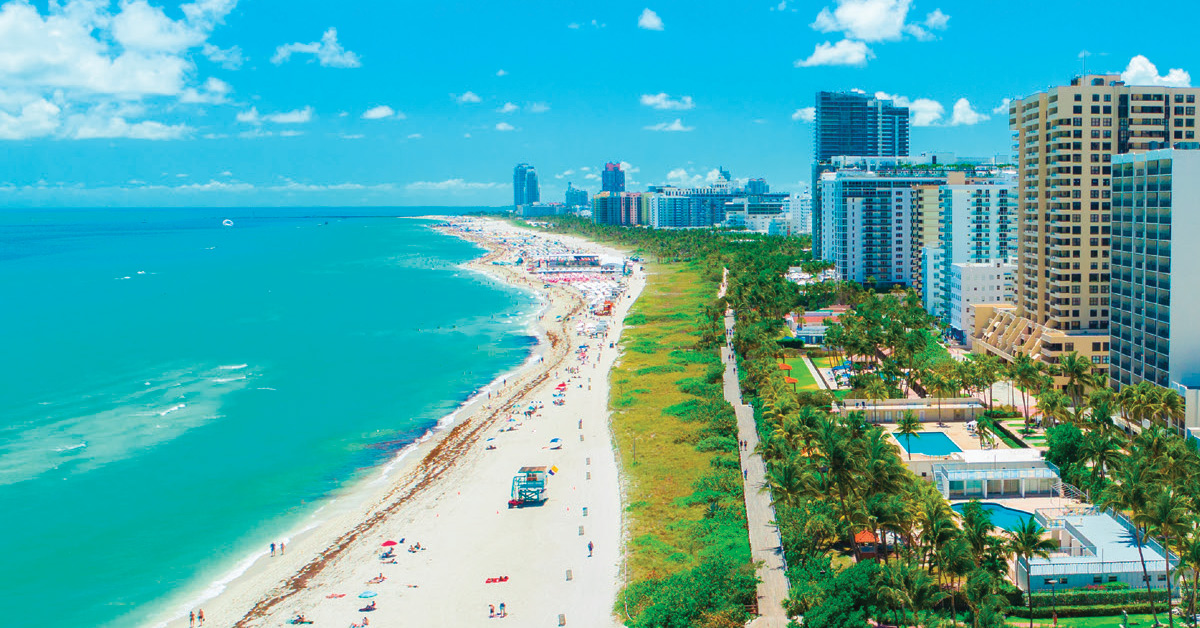Florida, also known as the Sunshine State, lives up to its moniker with average year-round temperatures in the mid-60s to upper 70s. As one of the top outdoors destinations in the U.S. — Florida has 175 state parks, 12 national parks and 825 miles of accessible beaches — tourism is a major economic driver for the state.
Although Florida had nearly 32 million visitors in the first quarter of this year, that represented a 10.7% drop-off compared to the first three months of 2019, according to Visit Florida. Hotels, restaurants, beaches and vacation rentals eased back into business this past May, but negative impacts due to coronavirus-related shutdowns were expected to worsen in the second quarter of 2020.
 At the peak of the crisis, the statewide number of hotel rooms sold per week plummeted annually by more than 75% while weekly hotel revenues were down annually by as much as $416 million, hotel-industry data provider STR reported. These figures had improved, however, by the latter portion of May.
At the peak of the crisis, the statewide number of hotel rooms sold per week plummeted annually by more than 75% while weekly hotel revenues were down annually by as much as $416 million, hotel-industry data provider STR reported. These figures had improved, however, by the latter portion of May.
With more than 21 million residents, Florida is the nation’s third most-populous state. According to the National Multifamily Housing Council, the Sunshine State has the fourth-largest apartment stock in the U.S. with some 1.4 million units as of 2018.
Results were mixed this past May for the state’s major apartment markets, Yardi Matrix reported. Tampa’s annual rent growth of 1.7% eclipsed the U.S. average of 0.8%, while Miami’s rents grew by 0.4% and Orlando’s shrank by 1%. Occupancy rates in these three markets declined by 30 to 70 basis points compared to May 2019.
According to a May 2020 forecast from a University of Central Florida economist, the state may have a protracted slowdown. Gross domestic product is expected to decline by 5.2% year over year in 2020 and won’t rebound to pre-pandemic levels until third-quarter 2021. More than 1.1 million Floridians had filed for unemployment during a seven-week period and the state was forecast to shed 767,000 jobs over the course of this year.
Early this past June, the rate of new unemployment claims across the state slowed by almost 50% on a weekly basis. Confirmed cases of coronavirus spiked around that time, however, as state officials relaxed quarantine provisions. Florida’s department of health had administered 1.6 million tests, with 98,000 positive results and 3,100 deaths, as of the third week of June.
According to the World Population Review, Florida’s five most-populous cities are Jacksonville, Miami, Tampa, Orlando and St. Petersburg, respectively. Each of them grew by more than 10% over the past decade. Enterprise Florida, an economic development group, reported that about 3,000 companies are headquartered in the Sunshine State. It noted that Florida ranks highly for its workforce-training programs, friendly business-tax climate and technology infrastructure. •
Miami-Dade County Office Market
 According to a first-quarter 2020 report from commercial real estate services company Avison Young, office-market fundamentals throughout Miami-Dade County were strong at the start of the year prior to the COVID-19 outbreak. On a year-over-year basis, the overall vacancy rate plummeted by 107 basis points to 11.4%, asking rents rose by 2.1% and net absorption increased by 17%.
According to a first-quarter 2020 report from commercial real estate services company Avison Young, office-market fundamentals throughout Miami-Dade County were strong at the start of the year prior to the COVID-19 outbreak. On a year-over-year basis, the overall vacancy rate plummeted by 107 basis points to 11.4%, asking rents rose by 2.1% and net absorption increased by 17%.
The broader impact of the coronavirus crisis was expected to show up in second-quarter 2020 data, although Avison Young noted that South Florida’s hospitality and tourism sector sustained immediate setbacks. The hospitality sector was responsible for about one in eight jobs in the county at the end of last year.
Avison Young reported four significant office-property transactions in the first quarter of this year, including a $29.3 million purchase near Miami International Airport and a $15 million purchase in the northeast submarket of Aventura. The company said that net absorption topped 159,000 square feet during the first three months of this year, with notable leases from Morgan Stanley, Spotify and brand-management company Yext.
Focus: International trade
According to a June 2020 report from Enterprise Florida, the Sunshine State ranked No. 7 in the U.S. last year with $56 billion in exported goods that originated in state, although that was a 2.1% year-over-year decline. Florida exported another $16.3 billion in products from other states. More than 58,000 Florida companies were international-trade participants in 2018, or 20% of all U.S. exporters, the second-largest share in the nation behind California.
In terms of dollar volume, Florida’s leading merchandise exports in 2019 were industrial machinery ($12.8 billion), electrical machinery ($11 billion), and aircraft and spacecraft parts ($10.9 billion). The state’s largest export partners were Brazil ($15.7 billion), Colombia ($4.5 billion) and Chile ($4.1 billion).
A report this past April in the Miami Herald noted that the coronavirus pandemic had interrupted trade and supply chains at local ports. Although passenger traffic at Miami International Airport was down significantly at that time, cargo traffic was robust due to high demand for medical equipment and supplies.
What the locals say
“In 2018, [Florida] had new residents that moved here from every state and the District of Columbia. And part of that is because of the unique tax structure that Florida has compared to a lot of other markets. We have no [personal] income tax and there is no corporate income tax (for many types of businesses). There’s a net benefit that we’ve had of a tax migration over the last several years, which always comes up when there are economic recessions. Tampa has got a great story — all the call centers that moved to that area after the Great Recession because they were looking for a lower-cost environment in which to do work.”

Chris Owen
Director of Florida research, Cushman & Wakefiled
3 Cities to Watch
Jacksonville
 With about 911,000 residents spread across some 840 square miles, Jacksonville is the most-populous city in Florida and the largest city in the U.S. by area. The city has a diverse economy that includes advanced manufacturing, aerospace, health care and logistics. More than 80 companies have national or divisional headquarters in the metro area, including Wells Fargo, AT&T, Gate Petroleum and the PGA Tour.
With about 911,000 residents spread across some 840 square miles, Jacksonville is the most-populous city in Florida and the largest city in the U.S. by area. The city has a diverse economy that includes advanced manufacturing, aerospace, health care and logistics. More than 80 companies have national or divisional headquarters in the metro area, including Wells Fargo, AT&T, Gate Petroleum and the PGA Tour.
Tampa
 This Gulf Coast city grew by nearly 19% from 2010 to 2019 and now has about 400,000 residents. Bolstered by neighboring St. Petersburg, the metro-area population exceeds 3.1 million. Across the metro area, the median household income is $54,900 and the median home value is $210,000. A Tampa Bay Times report from this past June indicated that Tampa’s office market is relatively stable and companies may not significantly shift their workforce to remote operations once the COVID-19 pandemic subsides.
This Gulf Coast city grew by nearly 19% from 2010 to 2019 and now has about 400,000 residents. Bolstered by neighboring St. Petersburg, the metro-area population exceeds 3.1 million. Across the metro area, the median household income is $54,900 and the median home value is $210,000. A Tampa Bay Times report from this past June indicated that Tampa’s office market is relatively stable and companies may not significantly shift their workforce to remote operations once the COVID-19 pandemic subsides.
Pensacola
 This city of 52,000 on the Florida Panhandle is more than 450 years old, making it the oldest European settlement in the nation. Naval Air Station Pensacola, established in 1914, is home to more than 23,000 military and civilian employees, including the world-famous Blue Angels. Across the metro area this past April, some 15,000 people lost their jobs as nonessential businesses closed, causing the area unemployment rate to soar from 4.3% to 12% month over month.
This city of 52,000 on the Florida Panhandle is more than 450 years old, making it the oldest European settlement in the nation. Naval Air Station Pensacola, established in 1914, is home to more than 23,000 military and civilian employees, including the world-famous Blue Angels. Across the metro area this past April, some 15,000 people lost their jobs as nonessential businesses closed, causing the area unemployment rate to soar from 4.3% to 12% month over month.
Sources: Avison Young; Enterprise Florida; Investopedia; JAXUSA Partnership; National Multifamily Housing Council; Naval Air Station Pensacola; Pensacola News Journal; Smithsonian Magazine; Sarasota Herald-Tribune; South Florida Sun Sentinel; STR; Tampa Bay Times; U.S. Bureau of Economic Analysis; U.S. Bureau of Labor Statistics; U.S. Census Bureau; Visit Florida; Visit Jacksonville; WJXT-TV; World Population Review; Yardi Matrix








